Money
Monetary policy attempts to address economic effects of the Covid-19 pandemic
As per the policy, commercial banks need to lend at least 15 percent to the agriculture sector by mid-July 2023; 15 percent to micro, small and medium enterprises; and 10 percent to the hydropower sector of their total loans by mid-July 2024.
Prithvi Man Shrestha & Sangam Prasain
Nepal’s central bank on Friday unveiled rescue packages through its annual monetary policy to mitigate the economic effects of Covid-19, promising to help support businesses get back on their feet.
Extension of the loan repayment deadline, refinance facility, grace period extension for infrastructure projects and targeted lending in productive sectors at cheaper rate are the key measures the Nepal Rastra Bank announced in its monetary policy for the fiscal year 2020-21 for relief and revival of various sectors affected by the virus.
The private sector and the primary opposition Nepali Congress welcomed some of the measures in the monetary policy to control money supply to achieve sustainable economic growth.
“Our demand was the ‘3R’—Reduce, Refinance and Restructure the loans—that the monetary policy has largely sought to address,” said Saurabh Jyoti, chairperson of the bank, finance and insurance committee at the Federation of Nepalese Chambers of Commerce and Industry, the apex private sector body.
Besides extending the deadline for paying loan instalments, the monetary policy announced by Governor Maha Prasad Adhikari also provisions mandatory lending to the sectors such as agriculture; micro, small and medium enterprises; and hydropower.
As part of providing relief, it has extended the deadline for paying loan instalments by six months, nine months and one year, depending on the degree of impact on the particular sector as the central bank seeks to ease the pains on the businesses caused by the pandemic.
It has permitted banks and financial institutions to extend further loans to industries and businesses affected badly by the pandemic by 20 percent of the working capital maintained at mid-April.
In order to revive the businesses severely hit by Covid-19, it has decided to provide refinance funds up to five times. However, the size of the fund has not been revealed.
As per the policy, exports and sick industries as well as other sectors will get special refinancing facilities at a maximum 3 percent interest rate, while micro, cottage and small industries will get credit at a maximum 5 percent interest rate.
Former finance minister Ram Sharan Mahat said that the central bank has come up with a policy that builds a positive state of expectations for the economy hit by the pandemic.
“As the overall goal of the monetary policy is to revive the country’s economy from the Covid-19 impact, it has addressed the key sectors for economic revival,” Mahat told the Post.
Mahat, who leads the economic special committee of the main oppositionNepali Congress, however, said that the policy is mum on the size of the refinance package.
“We had suggested that it should be worth at least Rs200 billion,” he said. “Overall, the monetary policy, however, sends a positive message.”
He also praised the mandatory requirement to lend to the agriculture sector and micro and small and medium enterprises.
As per the policy, commercial banks need to lend at least 15 percent to the agriculture sector by mid-July 2023; 15 percent to micro, small and medium enterprises; and 10 percent to the hydropower sector of the total loans by mid-July 2024.
Currently, they need to extend 10 percent loans to agriculture, 15 percent to energy and tourism sectors but both targets have not been met so far, according to the central bank.
The private sector said it is pleased that most of their key demands have been addressed by the monetary policy.
“The monetary policy has addressed most of our demands vis-a-vis rescue and revival of the businesses [in the wake of Covid-19],” said Chandra Dhakal, vice-president of the Federation of Nepalese Chambers of Commerce and Industry, the country’s apex private sector body.
“It has also introduced a policy to take care of small and medium enterprises, which have been badly affected by the pandemic.”
The private sector had demanded that the loan repayment reschedule be extended by six months after the lockdown for the sectors affected by the pandemic; and for others, an extension of the deadline by three months.
Governor Adhikari, however, announced that the borrowers of the worst affected sectors, which were supposed to pay the instalments by mid-July this year, could pay their dues by mid-July 2021.
The service industry—particularly the tourism and aviation sectors, and micro, small, and medium-scale enterprises—is among the worst hit by the pandemic, which has taken 40 lives and infected over 17,000 Nepalis as of Friday.
The sectors facing medium impact can now pay instalments by mid-April next year and those facing a mild impact can pay them by mid-January next year, according to the monetary policy.
Earlier, the central bank had extended the deadline for paying the instalments to mid-July this year from the regular deadline of mid-June through a review of the monetary policy introduced last fiscal year, which ended on Wednesday.
There is a provision of a fund worth Rs50 billion through which badly affected sectors like tourism and micro, small and medium enterprises get loans at a 5 percent interest rate for reviving the enterprises and paying staff salary.
This is the fund created as per the budgetary provision of the government.
The central bank also addressed the private sector’s demand that the core capital plus credit to deposit ratio (CCD ratio) be increased to 85 percent from 80 percent so that more liquidity could be available to the banking sector.
“This will create around Rs180 billion excess liquidity in the market which will help bring the interest rate down,” Jyoti of the Federation of Nepalese Chambers of Commerce and Industry said.
The private sector has been demanding that the average interest rate in lending must be below 10 percent during the pandemic.
The private sector had demanded that the spread rate between interest rate on deposits and credit should be brought down to 3 percent from the current requirement of 4.5 percent. The spread rate is the difference between the interest rate on deposits and lendings.
The bankers, however, were against such a provision. The central bank too has remained mum on the issue.
The private sector had also been demanding an exit policy through waiver of interest considering that many businesses were in no position to revive. The monetary policy, however, has failed to address this demand.
“We had made this demand considering that an easy exit would allow the entrepreneurs to start new businesses and create new jobs,” said Jyoti.
The private sector had demanded waiver of all interests to ease exit.
The central bank has also allowed banks and financial institutions to renew the short-term working capital loans such as demand loan and cash credit till mid-January next year by analysing the situation of the borrowers.
There are other relief measures as well.
If a borrower whose loan is active till mid-January next year and can propose a new timetable for repayment within that period can get the loan restructured or rescheduled by paying a minimum of 10 percent interest.
If restructuring and rescheduling of loans are not adequate to revive the worst-affected sectors, the central bank has also opened the door for reviving the enterprises through new investments by way of private equity funds, venture capital, debt equity conversion and special purpose vehicles.
As the lockdown affected the construction works of many industries and projects, the monetary policy has announced increasing the grace period for loan repayments.
During the grace period, the borrowers need not start to repay the loans. For the hotels accommodative of tourists, the arrangement will be made to extend the grace period by two years for one time.
Other sectors most affected by the pandemic will get a grace period extension of one year. Those facing medium impact will get an extension by nine months and marginally affected projects will get an extension by six months.
The tourism sector which has been badly affected by the pandemic will be eligible to get facilities announced under the Covid-19 recovery plan.
The policy says that the sector will be availed working capital, relief credit and refinance to revive the sector. They will be eased to get loans from the banks and financial institutions to complete the tourism project.
Binayak Shah, vice-president of the Hotel Association of Nepal, said the monetary policy has put in place some packages to address the crisis in the tourism sector, but it needs a prompt implementation.
“The allocation of Rs50 billion as a refinancing fund at 5 percent interest rate could be a big relief for the sector,” said Shah.
He, however, sought a separate mechanism to fast-track the implementation of the provisions by the central bank.
According to the Tourism Ministry, the tourism sector is estimated to face a loss of Rs40 billion as of July 21, the extended lockdown period.
According to Shah, it may take at least two years for the industry to return to normalcy.
“It means there could be no business for many hotels and other tourism businesses for the next two years,” said Shah. “So banks should be liberal and not ask for business plans before releasing the loan, which they normally do.”
For the banking sector, the policy has encouraged mergers with a number of incentives. It has relaxed the provisions related to provisioning in case the loans extended are related to Covid-19 affected sectors.
When the loan is not paid, the banks require to maintain a certain amount in reserve and cannot be counted as profit, which is called provisioning. How much provisioning should be made depends on the category of the loans which ranges from one percent to hundred percent.
A credit which had remained good until mid-January this year could be counted as good credit till mid-July.
“Even if an instalment is not paid by mid-July, the banks and financial institutions make provisioning of just 5 percent of such loans,” the monetary policy states.
Bhuvan Dahal, president of Nepal Bankers’ Association, said the monetary policy has sought to address the concerns of all sectors.
“Our concerns with regard to provisioning have been addressed,” said Dahal. “It, however, would have been better if the central bank had not fixed the fee to be charged by the banks on various services.”




 8.12°C Kathmandu
8.12°C Kathmandu
















